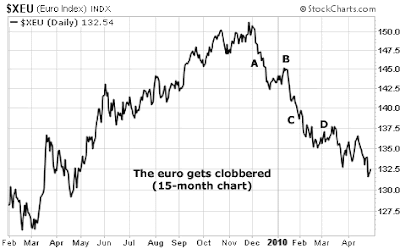"What this means is that we require, in one way or another, the collaboration of other companies on an international level precisely in order to recuperate our levels of production."
From time to time, my job as a resource stock analyst means I get to act as "BS interpreter."
This quote above, uttered by Mexican Energy Minister Georgina Kessel at an international conference a few weeks ago, is a mouthful of government gobbledygook. Here's what she's actually saying… and what it means for your resource portfolio…
Most Americans don't realize it, but Mexico is a major player in global oil production. According to the Energy Information Agency, it was the seventh largest oil-producing country in 2008. Mexico is the U.S.'s second-largest source of imported oil, behind Canada.
You read that correctly: We import more oil from Mexico than we do Saudi Arabia, Iraq, Kuwait, or any other Middle Eastern country. You don't read about it much in the papers, but Mexico is a critical supplier to American drivers.
Now, Mexican oil officials like Georgina Kessel have a problem… one the entire world has: There are no easy barrels left.
You see, in the oil business, there are "easy barrels," like the kind discovered in Mexico, Texas, and Saudi Arabia decades ago. These easy barrels burst from the earth when you puncture a highly pressurized oil field with a drill pipe. These are the barrels you see in movies and cartoons.
There are also "hard barrels," like the kind locked inside oil sands. They require enormous amounts of digging and processing in order to become the "light, sweet" crude that we turn into gasoline.
Another example of a "hard barrel" is one located hundreds of miles out into (and miles under) the ocean. This requires hundreds of millions of dollars in ships, advanced drilling technology, and undersea pipelines.
The world has plenty of hard barrels in reserve. Brazilian oil major Petrobras has discovered several "supergiant" fields (greater than 1 billion barrels) off the coast of Brazil. Canada and Venezuela have extraordinary amounts of oil trapped in tar sands. The U.S. has over a trillion barrels locked in shale formations out West. And since 2004, 63 new fields have been discovered in the Gulf of Mexico – 16 of those in water at least a mile deep.
It takes billions of dollars in infrastructure spending to develop these difficult fields. Hardly the easy oil of Mexico's past.
Mexico's legendary Cantarell field – discovered in 1976 and named for the fisherman who found it – is the sixth largest oil field on Earth. And it was once the second largest producing field in the world, after the massive Ghawar field in Saudi Arabia.
Cantarell was a once-in-a-lifetime discovery… so for years, Mexican officials could pretend they were oil experts. The field was so ridiculously productive, they could afford to nationalize the industry, steal the company blind, and pump the oil with abandon.
Production peaked in 2004 at 2.1 million barrels per day, which accounted for 64% of total oil production at Mexico's state-owned oil company, Pemex. But years and years of mistreating the golden goose has left its world-class oilfield in a sorry state of underproduction. Oil fields are like children… you have to take care of them and invest in their future.
The problem is that the government has done a terrible job of "upkeep."
Production at Cantarell plummeted 30% in 2008. It produced less than 780,000 barrels per day in 2009. And Pemex's total oil production fell 21% from 3.3 million barrels per day in 2004 to just 2.6 million barrels per day today.
Worse yet, thanks to decades of complacency, Pemex can't find more oil. In 2007, it managed to replace just 50% of its production. In 2008, it replaced just 70%. The new reserves it does find come from much smaller fields. The company is replacing million-barrel-per-day fields with 150,000-barrel-per-day fields.
Mexico – for years a major oil exporter – could become an oil importer within a decade. This is a disaster for the Mexican economy. Pemex employs over 100,000 people and supplies the Mexican government with around 40% of its revenue… and its oil revenue is wilting away.
Now that Cantarell isn't blasting out oil, industry insiders are seeing exactly how incompetent Pemex is. It's the General Motors of the oil world… If it weren't such an important exporter, it would be a joke.
What Mexico and Georgina Kessel are finally doing is admitting they need outside expertise in righting their ship. Take out the flowery government speak from Georgina's quote and you get:
"We are running out of oil. We underinvested in our infrastructure in favor of huge social programs. We've mismanaged our fields so badly that we need immediate help to find and pump more oil."
This is from a major player in the global oil export market.
For investors, this sort of comment is further reason to own oil and oil-service stocks for the long term. Major producers used to easy barrels – like Mexico, Venezuela, and Iran – are experiencing production declines… so much so that they will pull their exports from the market, sending prices higher. I wouldn't' be surprised to see oil over $200 a barrel in five years (especially if our spendthrift government keeps debasing the paper currency we use to price oil).
This will make "hard barrels" – like the kind in Canada's tar sands or deep offshore – much more valuable… But only the expensive and high-tech expertise that skilled oil-service companies provide can unlock that value.
Stay long oil… and stay long oil services.

















